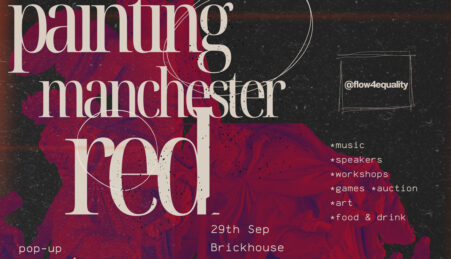By Freddie Bruhin-Price
A packed audience of literature enthusiasts gathered at the International Anthony Burgess Foundation for an evening of place writing. Psychgeographer David Cooper was in conversation with Rachel Lichtenstein about her writing career, with particular emphasis on her writing about place and space.

Rachel Lichtenstein explored the lives of immigrants living in London’s East End in her books On Brick Lane and Diamond Street
David Cooper provided an introduction for Rachel, a writer he has, “admired for a long time… and awkwardly, a writer I have recently written about.” David described Rachel’s first book, Rodinsky’s Room as, “difficult to define,” piquing the interest of anyone in the audience who was unfamiliar with it. He also directed the audience to postcards beneath their seats advertising the Diamond Street app, named after Rachel’s 2012 book of the same name. The app allows users to explore areas of London featuring in the book, such as Hatton Garden, through soundscapes which Rachel herself helped to create.
Rachel began by showing the audience slides of photographs from her family’s past. “The landscape of my imagination for a long time was Whitechapel,” she explained. “My grandparents told me of poets, artists, writers they knew, and this fuelled my desire to explore London’s streets.” After working for years as an artist and sculptor she began, “walking the streets of East London to build up a memory map,” from stories of the lives of people living in the area. Her journey lead to discover the room of David Rodinsky, whose disappearance in 1969 gave her the idea for her first book, Rodinsky’s Room.
In a short reading from the book, Rachel described a room which, “retained the oppressiveness of a religious space.” She explained her incessant, “cataloging of Rodinsky’s belongings and writings,” giving a sense of her great passion for her subject. She offered advice to aspiring novelists, “If you don’t have that insatiable curiosity, there’s no way you’re going to finish the book.”
Similarly meticulous research went into her subsequent books On Brick Lane (2007) and Diamond Street (2012) which explored Jewish London’s diamond trade. “In these books I started my research by exploring the lives of people who worked in the area,” Rachel explained. Speaking to David Cooper, Rachel told how her interest in archiving East London from a multitude of perspectives was, “a natural way for me to work. If you are writing about place, you can’t have a single voice. That why it felt important to talk to others.” With Diamond Street, the story of the street came together following an encounter with one man called Mitzy, whose story sparked a ream of research.

Rachel Lichtenstein’s books were on sale last night, including Diamond Street which now has its own app
Her interest in archiving people’s lives was encouraged early in her writing career by her long-time collaborator, writer Iain Sinclair. Speaking to Humanity Hallows, Rachel suggested that the reason her working relationship with Sinclair had been so long and fruitful was that their styles are “so different.” She expressed gratitude that the writer, “boldly took a gamble on a young female artist, which is what I was at the time, and to get behind my idea for this book [Rodinsky’s Room].” The result of this initial collaboration is a celebrated work, which alternates between Lichtenstein’s histories of Rodinsky’s Room and Sinclair’s biographical portrayal of Rachel, whom he has described as an, “archivist of the unconscious.”
Her upcoming book Estuary: A Deep Exploration of Place has a broader scope, focusing on the Thames Estuary. Rachel explained that this book was inspired by a boat trip, which became the subject of the film Estuary. The audience was further treated to a showing of this film, which comprises of footage of the river and a soundtrack of narration by Rachel and her fellow passengers, conjuring up stories from the Estuary’s past. As the night drew to a close, Rachel signed copies of her books for audience members, who left happily with a few more books to add to their shelves.
The Manchester Writing School’s Academic Director, Jean Sprackland, thanked the Burgess Foundation, the Manchester Writing School and the Institute of Humanities and Social Science Research for funding the event. She also acknowledged members of the audience who were attending as part of the Manchester Writing School’s three-day place writing course.
Upcoming courses at the Manchester Writing School include:
Reading and Writing Crime Fiction takes place on the 26th, 27th and 28th May 2015
A Many Splendored Thing: Writing (Well) About Relationships takes place on the 2nd, 3rd and 4th June 2015
From Historical Fact to Contemporary Fiction takes place on the 9th, 10th and 11th of June 2015
For more information please visit manchesterwritingschool.co.uk
***
Freddie Bruhin-Price likes playing bass and drinking all kinds of tea.







Leave a reply